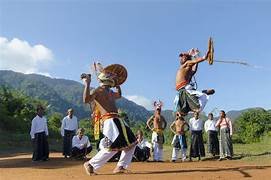Caci- The Traditional Martial Art of Manggarai

The Cultural Significance of Caci
Caci is a traditional whip-fighting performance deeply rooted in the Manggarai culture of Flores, Indonesia. This unique ritual is not just a form of entertainment but also a symbol of courage, strength, and masculinity. It is performed during significant ceremonies such as weddings, harvest celebrations, and traditional festivals.
The word “Caci“ means “fighting” in the Manggarai language, and the event represents honor, sportsmanship, and spiritual protection. This dynamic performance is a test of skill, agility, and endurance, where two fighters engage in a controlled yet intense battle.
Stages of the Caci Ceremony
The Caci performance follows several important stages, ensuring that it remains a sacred and respectful tradition.
1. Opening Ritual and Blessings
Before the fight begins, prayers and offerings are made to the ancestors and spirits to seek protection and blessings. Elders perform traditional rituals to invoke good fortune for the participants and ensure a fair fight. This stage highlights the deep spiritual connection within Manggarai traditions.
2. The Procession and Preparation
Participants arrive in a grand procession, dressed in traditional Manggarai attire. The fighters, known as “Paki” (challengers) and “Ta’u” (defenders), wear colorful woven sarongs, horned headdresses, and body ornaments. They also hold a rattan whip (agile weapon) and a buffalo-hide shield (defensive tool).
Traditional musical instruments like gongs and drums are played, setting the rhythm and creating a lively atmosphere. The fighters warm up, engaging in ritual dances that showcase their agility and readiness for combat.
3. The Duel Begins
The fight follows strict rules where one fighter attacks while the other defends. The objective is to strike the opponent’s body—particularly the back or shoulders—with the whip while avoiding being hit. Fighters use their shields to block attacks and counter with swift movements.
Each duel lasts a few rounds, and a referee ensures fair play and discipline. The strikes are powerful but controlled, emphasizing respect and honor rather than aggression. If a fighter successfully lands a strike, the audience cheers and celebrates the skillful move.
4. Celebration and Reconciliation
Once the duels conclude, the fighters shake hands and embrace, demonstrating the values of brotherhood and mutual respect. The event ends with a feast where the community gathers to celebrate the bravery of the participants.
This stage reinforces that Caci is not about rivalry or revenge, but about upholding tradition and strengthening communal bonds.
The Role of Caci in Manggarai Culture
Caci is more than a martial art—it is a living heritage that defines the identity of the Manggarai people. It serves as a rite of passage for young men, teaching them values of honor, patience, and resilience. The event also unites families and villages, fostering social harmony and cultural pride.
In modern times, Caci has gained recognition as a cultural tourism attraction, drawing visitors to witness this breathtaking display of tradition. Despite its growing popularity, efforts continue to preserve the authenticity of Caci and its deep-rooted spiritual significance.
Conclusion
The Caci event of Manggarai is an extraordinary tradition that showcases bravery, artistry, and cultural pride. Through its sacred rituals and thrilling duels, it remains an integral part of Flores’ rich heritage. Whether as a spiritual practice, a test of skill, or a community celebration, Caci continues to be a timeless symbol of courage and unity.


